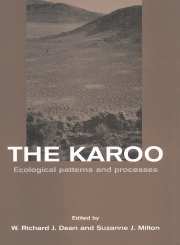Book contents
- Frontmatter
- Contents
- List of contributors
- Foreword
- Preface
- Acknowledgements
- Part one Biogeographic patterns and the driving variables
- 1 The climate of the karoo – a functional approach
- 2 Soils of the arid south-western zone of Africa
- 3 Palaeoenvironments
- 4 Plant biogeography, endemism and diversity
- 5 Biogeography, endemism and diversity of animals in the karoo
- Part two Form and function
- Part three Dynamics
- Part four Human impacts
- Part five Comparisons
- References
- Index
3 - Palaeoenvironments
Published online by Cambridge University Press: 23 December 2009
- Frontmatter
- Contents
- List of contributors
- Foreword
- Preface
- Acknowledgements
- Part one Biogeographic patterns and the driving variables
- 1 The climate of the karoo – a functional approach
- 2 Soils of the arid south-western zone of Africa
- 3 Palaeoenvironments
- 4 Plant biogeography, endemism and diversity
- 5 Biogeography, endemism and diversity of animals in the karoo
- Part two Form and function
- Part three Dynamics
- Part four Human impacts
- Part five Comparisons
- References
- Index
Summary
Introduction
The contemporary biogeography of any region such as the karoo is the culmination of a complex of processes operating over geological, evolutionary and ecological time. The Victorian geologist Charles Lyell put forward the principle of uniformitarianism – that the present is a key to the past – but to explain the biogeography of the karoo is to accept that it is the past that represents the true key to unlocking the observable patterns of the present (George, 1976). It is vital to know something of the history of a biological community in order that a reasoned explanation can be offered for its present distribution and ecology; in this way, the fourth dimension, time, is an important component of understanding the present and future distribution of that community. Different timescales are applicable to different kinds of geological and biological changes, for example broadscale geological changes are apparent only over longer time periods compared with, say, changes in the characteristic geomorphological or pedological processes of a region. This chapter offers a narrative history of the development of the phytogeography and zoogeography of the karoo seen against the backdrop of geological, geomorphological and climatic changes and, in so doing, emphasizes environmental change as a significant and consistent feature of the karoo. Such an understanding is crucial to the more appropriate management of karoo communities in a future which, like the past before it, will offer its unique array of environmental changes and challenges. One of the most potent of these challenges faced by biological communities is climate change.
- Type
- Chapter
- Information
- The KarooEcological Patterns and Processes, pp. 27 - 41Publisher: Cambridge University PressPrint publication year: 1999
- 5
- Cited by



